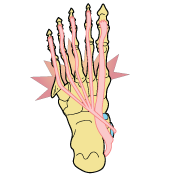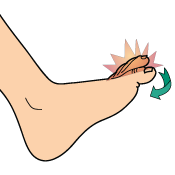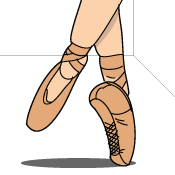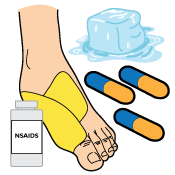 What is Flexor Tendonitis?
What is Flexor Tendonitis?
Flexor Tendonitis occurs when the tendon that is responsible for bending the big toe becomes irritated and inflamed, causing pain.
The Flexor Hallucis Longus muscle in your lower leg connects to the Flexor Hallucis Longus tendon, which runs down the inside of your ankle and foot to the big toe.
Signs & Symptoms
Signs and symptoms of Flexor Tendonitis include:
- Pain when bending the big toe
- Pain and tenderness along the inside of the ankle and foot
- Pain and stiffness in the big toe (worse in the morning)
- Slow onset of pain that worsens over time
Causes
 Flexor Tendonitis is usually an overuse injury, but can also be caused by a one-time trauma to the affected area or from degeneration over time. Dancers (especially ballet dancers) are prone to Flexor Tendonitis due to the stress put on the big toes. Sports that involve a lot of running and jumping also put you at risk of developing Flexor Tendonitis. Another cause is improper footwear. Wearing shoes that are the wrong size or worn out can potentially lead to Flexor Tendonitis.
Flexor Tendonitis is usually an overuse injury, but can also be caused by a one-time trauma to the affected area or from degeneration over time. Dancers (especially ballet dancers) are prone to Flexor Tendonitis due to the stress put on the big toes. Sports that involve a lot of running and jumping also put you at risk of developing Flexor Tendonitis. Another cause is improper footwear. Wearing shoes that are the wrong size or worn out can potentially lead to Flexor Tendonitis.
Treatment Options
RICE – Rest, Ice, Compression and Elevation are a good idea when treating Flexor Tendonitis. Resting the toe will help you avoid further injury. Ice and Compression work together to control the pain and swelling. Elevating your foot will help bring down any inflammation you’re experiencing.
NSAIDs – If the pain gets to be too much, you can take NSAIDs such as ibuprofen and naproxen to relieve the pain. Just be careful not to take painkillers if you’re planning on being physically active. Painkillers should only be taken during times of rest.
Taping – Taping the big toe and general area of the tendon can help provide additional support and protection. It also gives you extra compression to help bring down the swelling. Taping is definitely a good idea if you’re doing anything physical.
Physiotherapy – Exercises and massage can help relieve the symptoms of your Flexor Tendonitis and improve movement of the big toe.
Proper Footwear – Wearing shoes that fit is very important, especially if you’re physically active. You don’t want to wear shoes that squeeze your toes. Avoid shoes that are too tight or too loose. Make sure your shoes are suited to the activities that you’re doing.
Surgery – If conservative treatment methods haven’t helped, surgery is an option.